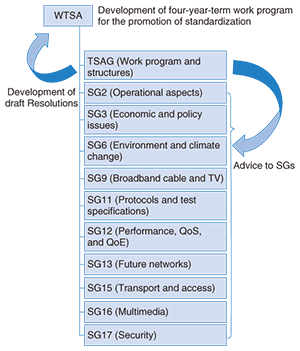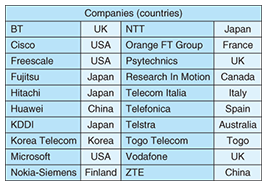 |
|||||||
|
|
|||||||
|
Global Standardization Activities Vol. 8, No. 8, pp. 52–54, Aug. 2010. https://doi.org/10.53829/ntr201008gls Establishment of New Focus Groups in ITU-TAbstractTwo new Focus Groups concerning smart grids and cloud computing were established in the ITU-T TSAG (International Telecommunication Union, Telecommunication Standardization Sector, Telecommunication Standardization Advisory Group) meeting held in Geneva, Switzerland, between February 8th and 10th, 2010.
1. TSAGThe Telecommunication Standardization Advisory Group (TSAG) is one of the groups in ITU-T (International Telecommunication Union, Telecommunication Standardization Sector) alongside the Study Groups (SGs) developing ITU-T Recommendations. They are all operated under the framework defined in the World Telecommunication Standardization Assembly (WTSA), which is held every four years (Fig. 1). The role of TSAG is to advise the Director of the Telecommunication Standardization Bureau (TSB), which is the secretary’s office of ITU-T, and the SGs on overall standardization management from the viewpoint of transversal cooperation among SGs. In addition, TSAG also has the function of establishing various groups. In the TSAG meeting in February 2010 (8th to 10th), smart grids and cloud computing were recognized as important subjects to be studied in ITU-T, and it was agreed to exploit the mechanisms of Focus Groups (FGs) for these two subjects.
2. FGsWTSA-00 (2000) adopted the FG mechanism, whose intention and role are defined in ITU-T Recommendation A.7. An FG is designed as a flexible group, even allowing participation from non-members of ITU-T, in order to accelerate the work in an SG in terms of a particular subject and to encourage SGs to cooperate transversally in new standardization areas that ITU-T has not previously tackled. An FG is expected to produce output documents called Deliverables through its activities, which normally last about one year, and to input them to relevant SGs. In the SGs, such Deliverables are quoted as important references in the development of ITU-T Recommendations. The triggers for FG establishment can differ according to the subject. For instance, with regard to information and communications technology (ICT) and climate change, for which ITU-T established an FG in 2008, the need for its work was initially agreed in TSAG and then two symposia recognized an FG as the best way to accelerate this work. On the other hand, in the case of smart grids and cloud computing, FG establishment was triggered by the CTO (Chief Technology Officer) [1] Group, which suggested the initiation of such work in ITU-T. The CTO Group is outlined in the following section. 3. CTO Group MeetingThe CTO Group was established in 2009, corresponding to Resolution 68 of WTSA-08 (2008), which recommended that the TSB Director take the following actions. a. Invite executives such as CTOs from industry to share their views on priorities and new areas of standardization so as to avoid a proliferation of standardization bodies. b. Circulate questionnaires to developing countries so that ITU-T can extract specific needs from them. c. Report progress related to this Resolution and knowledge obtained to the next WTSA. The CTO Group was established by the TSB Director in May 2009 to take care of the first recommendation. It consists of executives from twenty companies, including four Japanese companies (Table 1). In its first meeting in October 2009, there were discussions on hot topics in ICT standardization. In particular, the CTO Group asked ITU-T to identify the definitions and roles of smart grids and cloud computing, and this request was incorporated in the CTO Group Communique [2] for further consideration in ITU-T.
4. Two new FGsIn the February 2010 TSAG meeting, draft Terms of Reference (ToRs) were prepared to specify the scope and objectives of the two new FGs. Although ITU-T usually prepares ToRs by incorporating contributions submitted by Member States and Sector Members, in the case of these two FGs, TSAG first considered preliminary documents prepared by TSB, which contained the essence of the recommendation from the CTO Group meeting. Most participants, including the Japanese delegation, recognized the significance of these subjects, and the proposals to establish FGs for both subjects were unanimously agreed. The draft ToR development was done from scratch, and Japan participated positively to help develop acceptable texts for them, which were eventually agreed on the final day of the TSAG meeting. At the same time, two agreements were made: (1) TSAG will request that all ITU-T members review the draft ToRs for wider examination and give any comments to ITU-T within four weeks and (2) the FG Chairmen and Vice-Chairmen will be nominated accordingly (review finished in mid April). The scope of and expected deliverables agreed for each FG are given below. (1) FG on smart grids (i) Scope – Identify potential impacts on standards development. – Investigate future ITU-T study items and related actions. – Familiarize ITU-T and the standardization community with the emerging attributes of the smart grid. – Encourage collaboration between ITU-T and the smart grid community. (ii) Specific tasks and deliverables – Living list of standards bodies, fora, and consortia dealing with telecommunication/ICT aspects of smart grids, including information concerning their activities and documents in the context of smart grid standards framework. – Collection and summary of smart grid vision and value propositions with a focus on telecommunication/ICT aspects. – Terminology and taxonomy. – Analysis of communications networking requirement functions and capabilities to support smart grids (including quality of service/experience (QoS/QoE), security, and reliability). – Analysis of the energy and greenhouse gas impact of smart grids. – Gap analysis of standards for communications networking to support smart grids. – Use cases of services and reference models for telecommunication/ICT to support smart grids. – Roadmap to guide further development of relevant ITU-T Recommendations. (2) FG on cloud computing (i) Scope – Identify potential impacts on standards development and priorities for standards needed to promote and facilitate telecommunication/ICT support for cloud computing. – Investigate the need for future study items for fixed and mobile networks within the scope of ITU-T. – Analyze how interoperability can be assured in telecommunication/ICT support for cloud computing. – Familiarize ITU-T and the standardization community with the emerging attributes and challenges of telecommunication/ICT support for cloud computing. (ii) Specific tasks and Deliverables – Benefits of cloud computing from telecommunication/ICT perspectives. – Gap analysis of ITU-T standards for telecommunication/ICT to support cloud computing. – Collection and summary of cloud computing vision and value propositions with a focus on telecommunication/ICT aspects. – Analysis of the energy and greenhouse gas impacts of cloud computing. – Terminology and taxonomy to develop new definitions when necessary. – Analysis of telecommunication/ICT networking requirements, functions, and capabilities to support cloud computing services/applications (for both fixed and mobile telecommunications) – Use cases of services and reference models for telecommunication/ICT to support cloud computing. – Roadmap to guide further developments of relevant ITU-T Recommendations. After finalizing the ToR review, ITU-T announced that the first meetings of both FGs would be collocated in Geneva in June 2010. Prior to the February 2010 TSAG meeting, each FG was expected to identify a parent SG and other related SGs that would be intensively involved in the work of developing Recommendations. After TSAG approves the new study formation for smart grids and cloud computing, work in these areas will be further accelerated. 5. Concluding remarksThis article reported the establishment of two new FGs on smart grids and cloud computing in ITU-T. It is evident that similar work in other standardization bodies is becoming more intense. All concerned parties should try to remove potential overlapping and double standards through collaboration by fostering common views of overall system requirements as well as the service models and objectives of smart grids and cloud computing. In particular, since the role of telecommunications for these two subjects has not been discussed sufficiently, ITU-T initiative is expected here. References
|
|||||||










